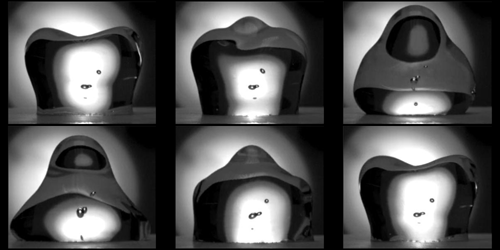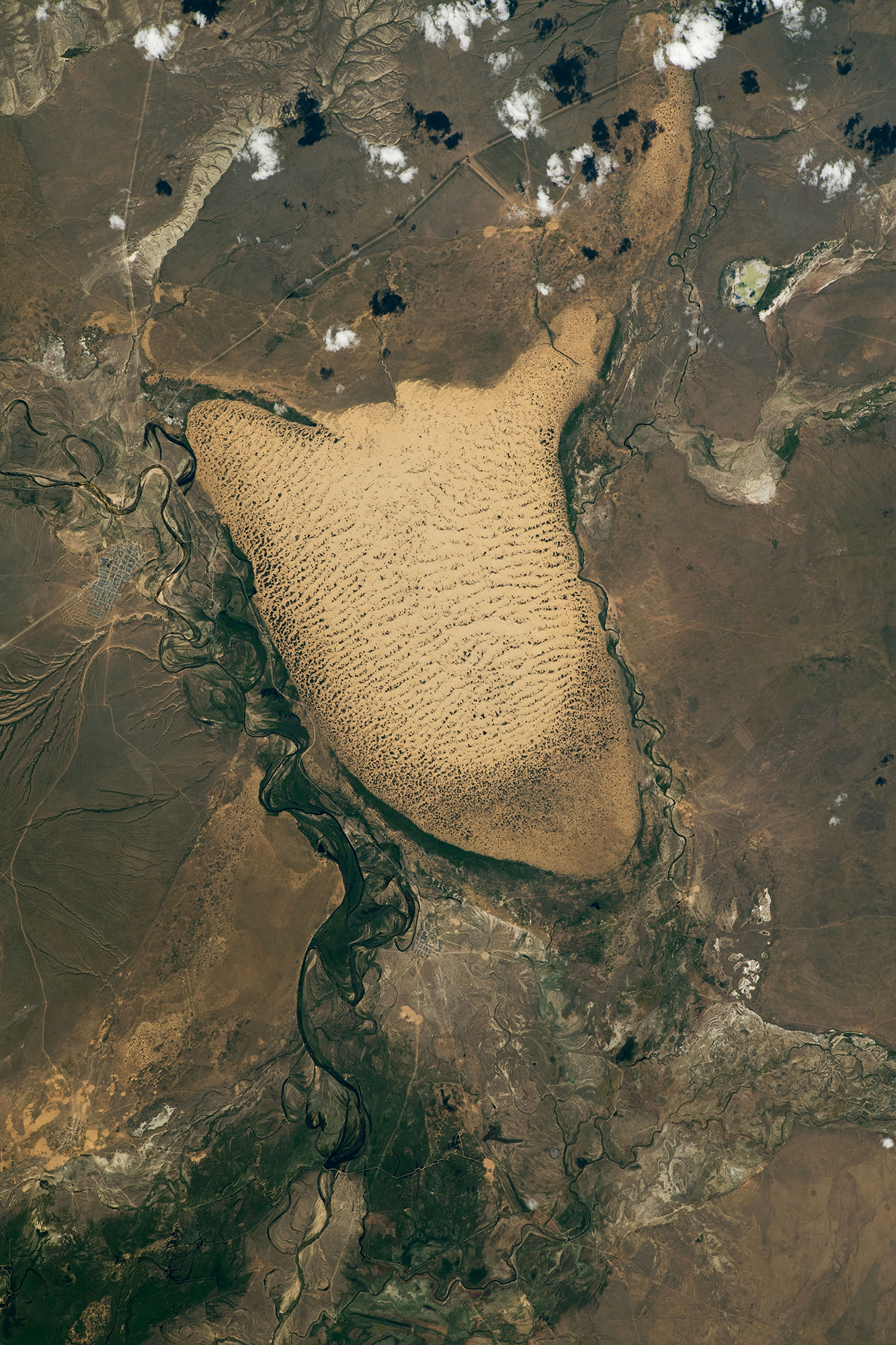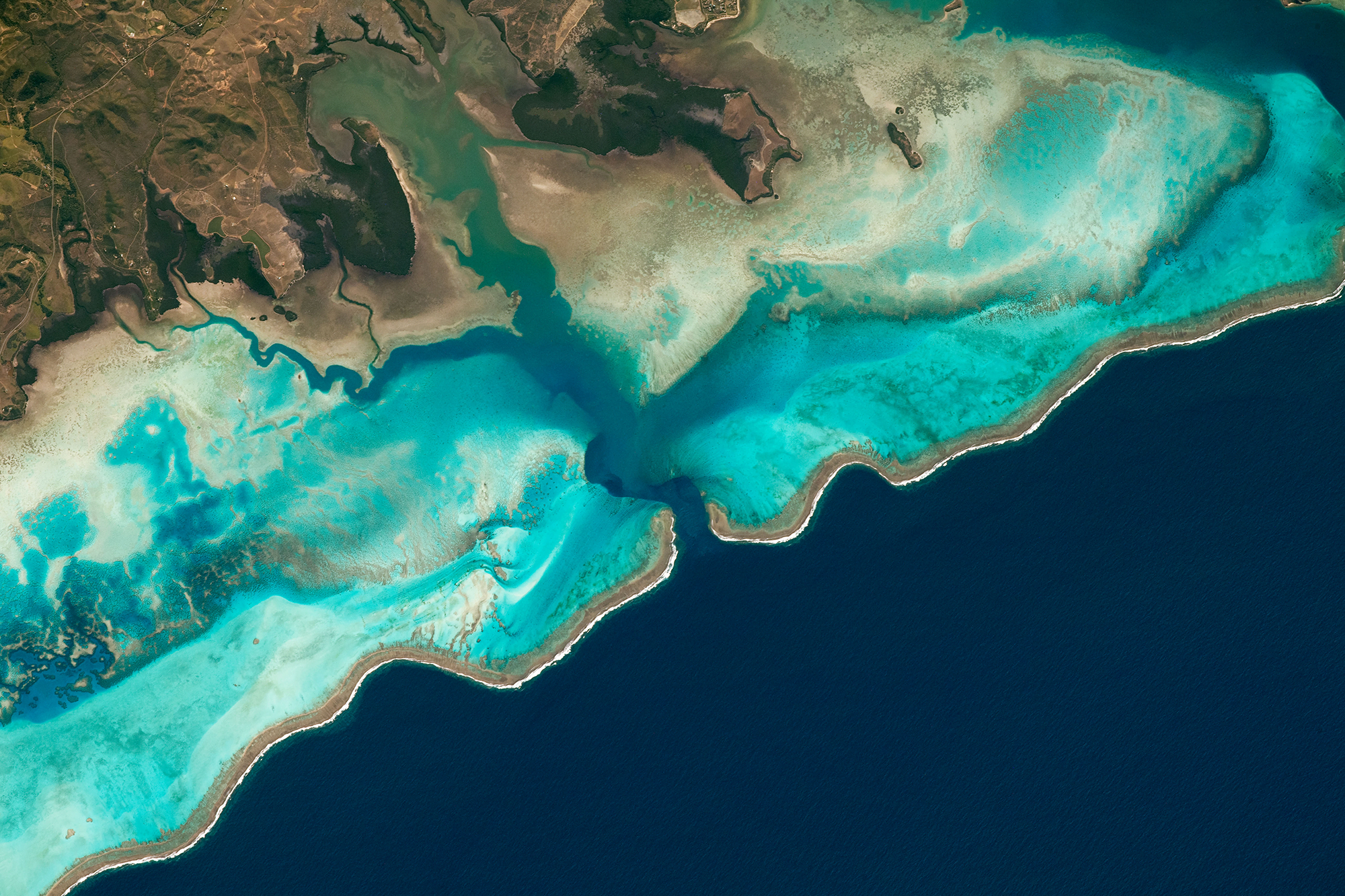Waterways twist through the wetlands of Adair Bay in this astronaut-captured image of northwestern Mexico. The estuary marks the transition between the Great Altar Desert and the Gulf of California. Fresh and salt water mix in the sediment-rich waterways. Mangroves and other salt-tolerant vegetation flourish in the coastal marsh. During low tides, evaporating water leaves behind salt flats, seen here in gray and white. High tides flood the area with nutrients that support both the vegetation and abundant aquatic life. (Image credit: NASA; via NASA Earth Observatory)
Tag: astronaut

Free Contact Lines
How a simple drop of water sits on a surface is a strangely complicated question. The answer depends on the droplet’s size, its chemistry, the roughness of the surface, and what kind of material it’s sitting on. Vetting the mathematical models that describe these behaviors is especially difficult since droplets often get stuck, or “pinned,” along their contact line where water, air, and surface meet.
To get around this issue, researchers sent their experiment to the International Space Station, asking astronauts to run the tests for them. Without gravity‘s influence squishing drops, the astronauts could use much larger droplets than they could on Earth. Larger drops are less likely to get pinned by a stray surface defect, so on the space station, astronauts could place droplets on a vibrating platform and observe their contact line freely moving as the drop changed shape. Under these conditions, the experiment tested many surfaces with different wetting characteristics, thereby gathering data to test models we cannot easily confirm on Earth. (Image and research credit: J. McCraney et al.; via APS Physics)

Dune Fields From Space
An astronaut captured this image of the Oyyl Dune Field in Kazakhstan from the International Space Station. To the south and east of the dune field (right and lower parts of image) there are fluvial floodplains, sources of sediment that feed the dunes. With sufficient wind and sand sources, the dune field has grown in a topographic low spot roughly 90 meters lower than the surrounding steppes. Dark specks scattered across the sands are clusters of vegetation, a sign that the dunes may get anchored rather than continue to shift in the wind. (Image credit: NASA; via NASA Earth Observatory)

Reefs Along New Caledonia
Brown reefs edge a turquoise lagoon in this astronaut snapshot of the New Caledonian coastline. Reefs like these form a natural barrier that protects coastlines from storms by breaking up waves (seen here as those white edges) before they reach the shore. The lagoon is streaked with lines of tan where sediment flows from the uplands into the water. Similarly, the color variations from green to blue in water hint at changes in depth, organic content, and more. (Image credit: NASA; via NASA Earth Observatory)

Rocked By Waves
This astronaut photo shows the Isles of Scilly off the Cornish coast. The pale turquoise waters mark shallow reefs and shoals between the islands while blues reveal deeper waters surrounding the isles. The sun angle is perfect for highlighting the complex wave patterns caused by the winds and tides. Look closely and you’ll see swells intersecting one another and even diffracting around the smaller islets. (Image credit: NASA; via NASA Earth Observatory)

Swirling Vortex
So much of fluid dynamics comes down to finding the right way to observe a flow. This image of a swirling tropical system was captured by an astronaut aboard the International Space Station in April 2019. The low sun angle at the time makes the shadows stretch long across the cloud tops, giving them greater definition as well as a tint of sunset color. As drastic as the system looks from this angle, it was a short-lived vortex that never made landfall, so it was never officially named. (Image credit: Expedition 59 Crew; via NASA Earth Observatory)

Drinking Coffee in Space
You probably don’t give much thought to the forces involved in drinking here on Earth. That’s because gravity’s effects dominate over everything else. Our cups are designed to hold a liquid until we use gravity to pour it into our mouths. But that technique doesn’t work in microgravity. There other forces govern how liquids flow: specifically surface tension and capillary action.
Both of these forces are the result of intermolecular attractions. In the case of surface tension, it’s the attraction that the molecules of a liquid feel for one another that keeps them in a cohesive bunch. Capillary action is similar, but it’s an attraction between the liquid molecules and those of the solid they’re wetting. When you combine them both, you get the ability for liquids to climb up a narrow gap and pull more liquid up behind them. That’s the key science behind every version of the “space cup” developed by astronaut Don Pettit and his collaborators.
To hear more about the development and engineering of the cup (and exactly why it makes drinking coffee so much more enjoyable in space than it would be otherwise) check out the full video. And, in case you’re wondering, there’s a special microgravity champagne flute, too! (Image and video credit: It’s Okay to Be Smart)

“The World Below”
Since the first cosmonauts and astronauts entered orbit around our planet, they’ve held a unique perspective. Thanks to the timelapse photography of recent astronauts aboard the ISS and the editing skills of photographer Bruce W. Berry, Jr, the rest of us can enjoy a taste of that viewpoint. Turn up the volume, fire up the big screen, and enjoy.
I particularly like how several of the sequences show off the depth of the atmosphere. Earth’s atmosphere is incredibly thin compared to the size of our planet – less than one percent of Earth’s radius – but thanks to the shadows that clouds cast on one another, you can really appreciate their height in sequences like the one at 2:26. (Video credit: B. Berry, Jr. using NASA footage)

Hair-Washing in Microgravity
I imagine that the most common questions astronauts get come in the form, “How do you do X in space?” In this video, astronaut Karen Nyberg demonstrates how she washes her hair in space. Using no-rinse shampoo, the process is not terribly different from on Earth: wet the hair, work in the shampoo, add a little more water, and use a towel and comb to work it through all the hair. The big difference is that Nyberg’s hair sticks almost straight up the whole time. That’s an effect of microgravity, obviously, but there are fluid forces at play, too, namely elastocapillarity.
Hair typically feels quite different when it’s wet. Strands bunch together and feel stiffer. This is because of the water trapped in the narrow space between individual hairs. The water’s fluid characteristics (capillarity) affect the solid hairs and change their elastic properties – hence elastocapillarity. We see this on Earth, of course, but the effect is especially noticeable without gravity pulling the wet hair down. (Video credit: K. Nyberg/NASA; via APOD; submitted by Guillaume D.)

Blowing Bubbles in Space
Blowing bubbles in your fruit juice is a bad idea when you’re in space, as astronaut Jack Fischer demonstrates. On Earth, gravity dominates water’s behavior, except when things are very small. But in microgravity, a liquid’s other characteristics become more obvious. Adhesion between the straw and juice guides it up and onto Fischer’s face. Surface tension is strong enough to hold the expanding juice bubble together. Capillary action, the ability of fluids to climb up narrow spaces, is far more apparent in microgravity as well, although it’s not important for this demo. We sometimes forget how powerful these forces can be, but microgravity is a good reminder that fluids are more complicated than we think. (Image credit: J. Fischer, source)









